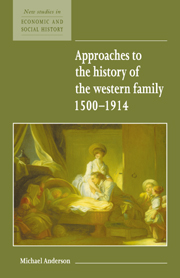2 - The demographic approach
Published online by Cambridge University Press: 05 June 2012
Summary
Before the mid-1950s family history as we know it today was almost nonexistent. Most work was limited to single families or small élite groups or was based mainly on impressionistic literary sources. Very little was known about the family life of the mass of the population.
Then, in the mid-1950s a group of demographers in France greatly refined (and extended to the populations of whole communities) the old technique of using the parish registers of baptisms, burials and marriages to link together the entries which related to the same individual and family (a useful introduction to this work by Goubert is in [11]). The findings derived from this ‘family reconstitution’ – and notably the demonstration of the use of some form of conscious family limitation among the Genevan bourgeoisie as early as the seventeenth century – caused other scholars to take up their methods and to extend this demographic approach to other sources of data. It is this body of work which is reviewed in this chapter.
The basic principles which inform this approach have their inspiration in the methods of natural science and of quantitative social science. The pioneering work of the Cambridge Group for the History of Population and Social Structure, for example, has been particularly concerned with the development of rigorous, standardised and quantitative research procedures aimed at generating data comparable both over long periods of time and across communities and societies.
- Type
- Chapter
- Information
- Publisher: Cambridge University PressPrint publication year: 1995

